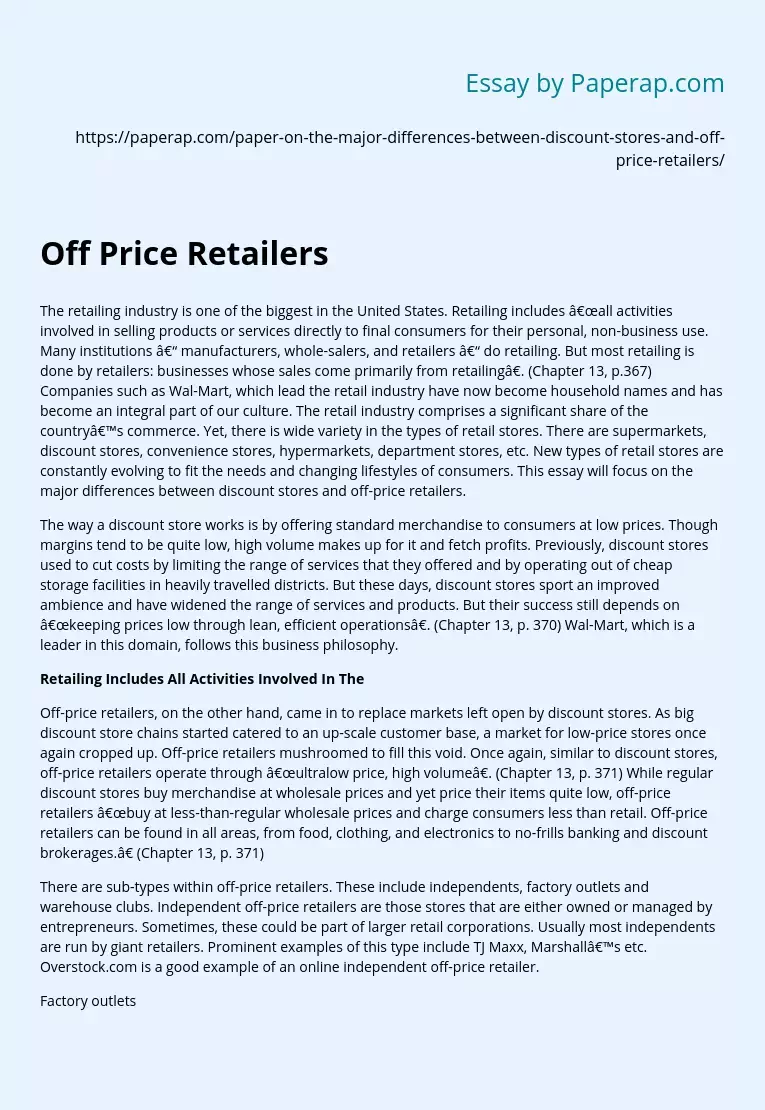Retailing Includes All Activities Involved In The
The retailing industry is one of the biggest in the United States. Retailing includes “all activities involved in selling products or services directly to final consumers for their personal, non-business use. Many institutions – manufacturers, whole-salers, and retailers – do retailing. But most retailing is done by retailers: businesses whose sales come primarily from retailing”. (Chapter 13, p.367) Companies such as Wal-Mart, which lead the retail industry have now become household names and has become an integral part of our culture. The retail industry comprises a significant share of the country’s commerce.
Yet, there is wide variety in the types of retail stores. There are supermarkets, discount stores, convenience stores, hypermarkets, department stores, etc. New types of retail stores are constantly evolving to fit the needs and changing lifestyles of consumers. This essay will focus on the major differences between discount stores and off-price retailers.
The way a discount store works is by offering standard merchandise to consumers at low prices. Though margins tend to be quite low, high volume makes up for it and fetch profits.
Previously, discount stores used to cut costs by limiting the range of services that they offered and by operating out of cheap storage facilities in heavily travelled districts. But these days, discount stores sport an improved ambience and have widened the range of services and products. But their success still depends on “keeping prices low through lean, efficient operations”. (Chapter 13, p. 370) Wal-Mart, which is a leader in this domain, follows this business philosophy.
Off-price retailers, on the other hand, came in to replace markets left open by discount stores.
As big discount store chains started catered to an up-scale customer base, a market for low-price stores once again cropped up. Off-price retailers mushroomed to fill this void. Once again, similar to discount stores, off-price retailers operate through “ultralow price, high volume”. (Chapter 13, p. 371) While regular discount stores buy merchandise at wholesale prices and yet price their items quite low, off-price retailers “buy at less-than-regular wholesale prices and charge consumers less than retail. Off-price retailers can be found in all areas, from food, clothing, and electronics to no-frills banking and discount brokerages.” (Chapter 13, p. 371)
There are sub-types within off-price retailers. These include independents, factory outlets and warehouse clubs. Independent off-price retailers are those stores that are either owned or managed by entrepreneurs. Sometimes, these could be part of larger retail corporations. Usually most independents are run by giant retailers. Prominent examples of this type include TJ Maxx, Marshall’s etc. Overstock.com is a good example of an online independent off-price retailer.
Factory outlets are another type of off-price retailers. These are “producer-operated” stores, prominent examples of which include Liz Claiborne, Carters, Levi Strauss, etc. Sometimes classified under “factory outlet malls and value-retail centers, where dozens of outlet stores offer prices as low as 50 percent below retail on a wide range of items”. (Chapter 13, p.372) Finally, warehouse clubs or membership warehouses “operate in huge, drafty, warehouselike facilities and offer few frills. Customers themselves must wrestle furniture, heavy appliances, and other large items to the checkout line. Such clubs make no home deliveries and often accept no credit cards. However, they do offer ultralow prices and surprise deals on selected branded merchandise.” (Chapter 13, p.372)
The retailing industry is one of the biggest in the United States. Retailing includes “all activities involved in selling products or services directly to final consumers for their personal, non-business use. Many institutions – manufacturers, whole-salers, and retailers – do retailing. But most retailing is done by retailers: businesses whose sales come primarily from retailing”. (Chapter 13, p.367) Companies such as Wal-Mart, which lead the retail industry have now become household names and has become an integral part of our culture. The retail industry comprises a significant share of the country’s commerce. Yet, there is wide variety in the types of retail stores. There are supermarkets, discount stores, convenience stores, hypermarkets, department stores, etc. New types of retail stores are constantly evolving to fit the needs and changing lifestyles of consumers. This essay will focus on the major differences between discount stores and off-price .
Retailing Includes All Activities Involved In The. (2019, Dec 05). Retrieved from https://paperap.com/paper-on-the-major-differences-between-discount-stores-and-off-price-retailers/

